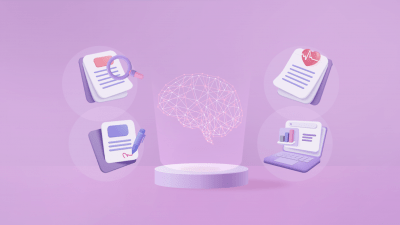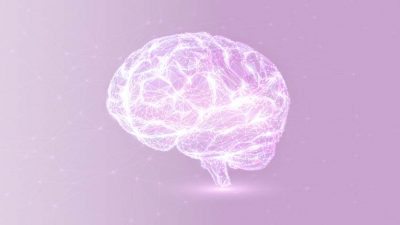Last Updated on: 2nd February 2024, 12:43 pm
Each of us experiences contact with artificial intelligence every day. We reach for its possibilities spontaneously and often without realizing that it is to artificial intelligence that we owe the comfort of life and a number of conveniences. Who doesn’t use Gmail, Google Translate, a smart personal assistant or Netflix recommendations? We also watch dozens of ads every day, which are often selected for us by algorithms. How has the evolution of Artificial Intelligence progressed and impacted our lives over the course of history?
In this article, you will learn:
- The history and evolution of Artificial Intelligence
- How applications of artificial intelligence were initially used
- How businesses use AI today
- Several known practical applications of AI
- What using AI could bring in the near future
Table of Contents:
- Artificial Intelligence origin story
- Dawn of the machines
- Renewed interest and modern development of AI
- The evolution of AI on the example of chess duels
- Where are artificial intelligence algorithms used today?
- The evolution of AI—examples in our everyday lives
- What awaits AI in the future?
Artificial Intelligence origin story
Once upon a time, in the ancient world, people dreamed of creating artificial beings with human-like intelligence. These dreams were told in myths and stories, like the Greek tale of the humanoid robot Talos, sculpted from bronze by Hephaestus to defend Crete against invaders.
In the philosophical realm of the 17th century, René Descartes and Gottfried Wilhelm Leibniz pondered the notion of mechanical reasoning devices. They envisioned a world where intricate machines could mimic human thought processes, where gears and levers could simulate human intellect.
These early visions were the sparks of inspiration, the flickers of the AI story that was yet to be fully written. While Pygmalion’s statue remained a sculpture, and Descartes and Leibniz’s mechanical devices were but dreams, the idea of intelligent machines began to take shape.
Dawn of the machines
Jump forward to the 19th century, and inventors like Charles Babbage were building early mechanical wonders. Babbage’s Analytical Engine laid the groundwork for modern computers and the eventual emergence of AI.
But it wasn’t until the 20th century that the real AI adventure began. A brilliant British mathematician named Alan Turing imagined the concept of a “universal machine” that could perform any computational task and solve algorithms. During World War II, he and others developed early computing devices that could crack enemy codes, showcasing a hint of Machine Learning and making Turing the father of Artificial Intelligence.
In 1956, a group of researchers, including John McCarthy, gathered at the Dartmouth Conference and coined the term “Artificial Intelligence.” They believed that machines could simulate human-like thinking. During this time, AI pioneers explored symbolic AI, a world of rule-based systems and logical reasoning. They created programs like the Logic Theorist and the General Problem Solver to tackle mathematical puzzles, and the natural language processor ELIZA to simulate a psychotherapist.
However, the 1970s brought a cold spell known as the “AI winter,” which lasted until 1980. High expectations collided with slow progress, leading to funding cuts and a sense of disillusionment. AI research turned to expert systems and knowledge representation.
Renewed interest and modern development of AI
The early 1980s saw the separation of Artificial Intelligence and machine learning, which until then had served as a training program for Artificial Intelligence. Artificial Intelligence research thus moved away from algorithms and began to focus on using logical knowledge-based approaches. Machine learning, on the other hand, has become a separate field that focuses on solving practical problems. The dynamic development of this area can be attributed to not only a large number of researchers and neural network specialists, but also the growing popularity of the Internet, which not only allowed its solutions to be shared with a wider audience, but also significantly facilitated access to digital data.
As the 21st century dawned, the world of AI changed once more. With mountains of data and massive computational power at their disposal, researchers made stunning breakthroughs in Machine Learning. Deep Learning, in particular, led to the development of remarkable technologies like image and speech recognition, autonomous systems, and natural language processing (NLP).
Soon, the first autonomous vehicles appeared, programs able to draw like a human, translate into many languages or process natural language. In time, the first solutions allowing for speech or face recognition appeared. In the following years their precision and capabilities were significantly improved, thanks to which today Artificial Intelligence is widely used in almost every aspect of our lives.
The evolution of AI on the example of chess duels
The beginnings of artificial intelligence development were simple programs that were adapted to the capabilities of computers at the time. It is not surprising that one of the first programs created by the pioneers of artificial intelligence was a program to play chess. This simple and extremely popular game has become a kind of witness to the evolution of artificial intelligence. It is therefore an excellent example to better understand the differences between artificial intelligence (AI), machine learning (ML) and Deep Learning (DL).
See also: Deep Learning vs Machine Learning in Advertising
In the case of artificial intelligence (AI), it is possible to write a program which will, on the basis of some predefined logic rules, play chess. But the program doesn’t necessarily have to take into account any additional data like the knowledge gathered from previous game sets, etc.
In the case of using machine learning (ML), the algorithm playing chess will, apart from the predefined rules (as it is in general AI example), learn from different master players’ moves, check parts of the game, etc. In most cases the overall ‘chess game problem’ will be divided into subproblems, like:
- how to optimally begin the game (probably based on predefined rules – chess openings),
- how to optimally solve middle-game problems (usually based on some data like different grandmasters plays to evaluate specific positions),
- how to optimally solve end-game problems (when there is a small number of pieces on the board, there is usually a possibility for exact simulation of each move till the end, to choose the optimal next move).
So there is usually a mix of different techniques optimized towards solving some subproblems, in order to solve a higher-level problem. Specific machine learning algorithms can be used on some level. In that case the more data from previous sets it has, the more and faster it can learn how to win the game.
Deep Learning (DL) algorithms allow not only to solve specific, simpler subproblems but can also learn what the dependencies between those subproblems (layers) are, so those algorithms are capable of solving the whole higher-level problem without manually dividing it and solving each subproblem independently. In the “chess game example” such an algorithm could ideally learn only from a set of historical chess games and could automatically detect that there is a need to divide those plays into parts, like the beginning, mid- and end-game. The ideal algorithm would learn how to optimally play the end-game. Based on that it would solve the middle-game problem and based on that it would also solve the problem of how to begin the game in order to have the best mid-game position. And all that without human justification, manually implemented additional rules and so on.
Where are Artificial Intelligence algorithms used today?
Today, artificial intelligence accompanies us almost at every step. It is used not only for the development of autonomous vehicles and robots, but also to conquer space, explore the galaxy, support medics in identifying disease entities and disturbing changes in X-rays, as well as solving many problems faced by business every day.
We are talking about processing huge data sets and supporting management in making key decisions, recommending optimal solutions, forecasting supply and demand, dynamic pricing or inventory optimization. This also applies to broadly understood marketing activities. Today, artificial intelligence decides not only what banner and content to present to the user, but also analyzes all the available information to decide whether it makes sense and will result in the desired action. AI also stands behind the best recommendation engines that tells us every day what songs, movies or products we may like.
Artificial intelligence allows us not only to improve, but also automate many business processes and thus generate tangible benefits for the organization. No one should be surprised, therefore, that business is so eager to reach for new technology and find more and more new possibilities of its application.
The evolution of AI—examples in our everyday lives
How often artificial intelligence enters our lives is perfectly illustrated by specific examples of its use. We have probably already had the opportunity to come across some of them, but it is very possible that we did not even realize that the specific solutions or improvements are due to artificial intelligence. What specific solutions are we talking about?
Gaming industry – Deep Learning to improve graphics
Expert Chintan Trivedi tried to find out whether the recent developments in Deep Learning can help to improve the graphics while simultaneously also reducing the efforts required to create them. He tried to focus on improving the players’ faces in FIFA using the famous deepfakes algorithm. This is a Deep Neural Network that can be trained to learn and generate extremely realistic human faces. His focus in this project lies on recreating the players’ faces from within the game and improving them to make them look exactly like the actual players.
What is the result of the work of AI experts on FIFA? HyperMotion is already up and working, but only on the PlayStation 5 and Xbox Series S/X versions of FIFA 22. It brings more fluidity and realism while playing and at the same time more accurately simulating real-life football.
This solution, after a lot of development, focusing on recreating actual bodies (not only faces) could be used in the fashion sector, while making visualizations for trying on clothes. This is a nice and very visual example of how Deep Learning can improve something we already thought was almost excellent.
Gaming industry – Deep Learning to improve quality
Electronic Arts, the company behind FIFA, among others, also uses artificial intelligence to test its games. By introducing a self-learning mechanism into game testing structures, player behavior can be replicated and many annoying bugs identified. As a result, experienced testers can focus on fundamental testing and leave the most tedious and time-consuming tasks to technology.
„With neural networks learning how to play the games by themselves we can mimic human-like behaviors that go beyond current automated testing approaches, of scripted bots, where the game learns and plays like a human. This means we find bugs faster, in ways that humans do, before they get out in the wild to millions of players” – Colin Barre-Brisebois, EA SEED Head of Technology.
You can test your store’s performance in the same way and quickly identify issues that can have a very negative impact on conversions or revenue.
Google Translate
Initially, Google’s linguistic data was obtained from the United Nations and European Parliament documents. At present, AI stands behind the high and still growing accuracy of translations. The huge step was taken in 2016 when Google implemented Deep Learning methodology – Neural Machine Translation (NMT) which results in using a wide variety of linguistic sources. High quality training data taken from the Internet (after reducing the noise in data) allows Google to constantly improve models that are in use and reduce more and more errors in translation.
From the e-commerce perspective, this kind of a solution can be a real game-changer in terms of opening e-commerce services into different markets. For instance if some European e-commerce would like to open to the Japanese market, it would need to translate not only static elements of the website (which is quite easy even without a good automatic solution), but it would also have to maintain the translations of thousands of rotating offer names, their descriptions and users reviews, which would practically be effortless if great translation solutions were available. In the future, Deep Learning algorithms could become even better than human language translators, similarly to how they became better than humans in handwriting recognition problems.
What awaits AI in the future?
Artificial intelligence is already revolutionizing our daily lives and the way many industries and businesses operate. Moreover, there is no indication that this trend will reverse in the near future. On the contrary, artificial intelligence has become a catalyst for the development of many new technologies (including robotics, big data and IoT) and everything indicates that this role will continue in the coming years.
And although today certain areas and aspects of our lives still seem to be virgin territory for the development of artificial intelligence, we should expect that this may soon change. Of course, this does not mean that those areas that already boast numerous examples of the application of artificial intelligence will stop witnessing the dynamic development of the technology. Scientists will continue to put a lot of effort and energy into developing autonomous vehicles, improving robots that can replace humans in many repetitive tasks in the manufacturing industry, or more accurately diagnosing disease entities.
The marketing industry is also likely to face major changes – we can expect even better-suited ads to the context of the search, more relevant recommendations and personalization taken to a completely new level, which from the business perspective will result in better customer experience and increased sales.
And so, the AI story continues, full of innovation, challenges, and boundless possibilities. It’s a dynamic journey that is still unfolding, shaping the world in ways we could only imagine in our wildest dreams.
If you have any questions, comments or issues, or you’re interested in meeting with us, please get in touch.





